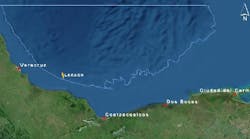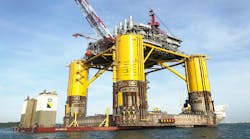Studies assess technical and safety challenge
Nick Terdre
Contributing Editor
Most of Norway's concrete gravity-base platforms, with the exception of Statfjord A, are to remain in operation for many years to come. However, the Norwegian Petroleum Directorate (NPD) is investigating the complex issue of whether these giant structures can be refloated and disposed of on land whenever their time is up.
The initiative was prompted by a report into the environmental effects of decommissioning offshore installations prepared last year under the leadership of the Climate and Pollution Agency (CPA), and to which the NPD also contributed. Erle Heggen Mæland, senior engineer at the NPD, is heading the directorate's work in this area.
The report recommended the “establishment of a joint project together with other relevant authorities to consider future problems and measures in connection with the removal and decommissioning of concrete installations.” As a result, the NPD teamed last winter with the CPA and the Petroleum Safety Authority to study key issues relating to the disposal of concrete platforms, including the technical challenges, costs, and consequences for health, safety, and the environment. Their findings will be issued in a report early in 2012 and put out to consultation.
As part of this project, concrete specialist Dr techn. Olav Olsen performed a study last year into technical factors concerning the refloating of concrete platforms and their transport to land. A second study, on the technical challenges related to the transport and onshore dismantling of concrete platforms, was commissioned earlier this year from contractor AF Decom Offshore. This study, which has a budget of NKr 500,000 ($90,000), is due to be delivered in December.
Recovering concrete platforms to shore would comply with Ospar's guidelines on the disposal of offshore installations. But Ospar – the convention for the protection of the marine environment of the northwest Atlantic – left open the possibility of derogation from this ruling for a variety of reasons, including technical and safety risks, environmental impacts, and economic factors.
The five concrete platforms which already have been decommissioned from the Norwegian and UK sectors have been left in situ. And that solution can be taken as the default case, for even though in 1978 the Norwegian authorities introduced a requirement that all Condeeps should be designed for refloating, in each case it will have to be shown that such an operation is technically feasible and can be executed without any risk to people, assets, or the environment.
10 Condeeps to go
Currently there are 10 concrete gravity-base platforms in the Norwegian sector, all of them Condeeps. In UK waters there are three Condeeps in operation, plus one concrete platform of another design.
The Condeep design.
The work by Olav Olsen in developing the Condeep design was a generic study that nevetheless represented the state-of-the-art. It pulled together the results of previous work such as a joint industry project in the late 1990s, said Kolbjørn Høyland, the director of the company's offshore and marine structures division. Other refloating studies have been carried out by Shell, focusing on the Brent D platform in the UK sector and Draugen in the Norwegian sector. Brent D, one of three Brent platforms with concrete bases, could cease production as early as the end of this year.
All these studies conclude that, from a technical point of view, refloating is possible, but there are uncertainties, some of which are difficult to reduce to within acceptable limits, Høyland noted. All the derogation requests submitted to Ospar so far have been based on the argument that the risks of refloating the platform in question were too high.
That may not continue to be the case for future projects. Høyland pointed out that continuing technology development is making some of the operations involved in refloating easier and more reliable. This applies to tools, such as ROVs, and equipment, such as valves and pumps. Moreover, operations can be monitored much more closely, while modeling and simulation of the refloating operation can be performed much more accurately thanks to the development of non-linear finite element calculating techniques.
Typical of the Condeep design is the cluster of usually 19 or 24 cylindrical cells which form the base, the walls of which extend downwards to form the skirts which penetrate into the seabed and hold the platform in place. The base also provides the foundation for three or four shafts – or in the case of the Draugen platform, just one – on which the topsides rest. The platforms have been installed in a range of water depths, from 82 m (269 ft) in the case of Sleipner A to 303 m (994 ft) for Troll A.
Being concrete these platforms not surprisingly are heavy. Troll A weighs just over 1 million metric tons (1.1 million tons) and Gullfaks C just under that.
Assessment issues
The uncertainties become apparent from an early stage in the process of planning for refloating, when the state of the structure is assessed. For example, the structural integrity of the concrete can be affected by cracking, which can occur in places such as the spaces between the cells which are difficult to inspect, or by damage suffered during installation or in the operational phase, as has happened with some platforms.
Next in line for decommissioning – Statoil's Statfjord A platform. (Photo: Marit Hommedal/Statoil)
A key element in the offshore preparations is the closing of the conductor and other openings, an operation that has to be performed remotely by ROVs. If the openings are not made properly water-tight, it will be impossible to create the necessary pressure within the skirts to free the base from the seabed.
Freeing the skirts from the seabed calls for a high degree of control to ensure that as the buoyancy of the structure changes from negative to positive, it does not suddenly break free in an uncontrolled fashion. This control is best achieved by a combination of pumping out ballast water from the cells and pumping in water under the skirts.
Maintaining the correct amount of pressure – not too little, but not too much – is crucial, but knowing what these limits are is not easy to calculate. As the study says, “…freeing the platform is therefore an operation which involves great risk.”
Another unknown is what will happen to the grout which has been injected under the skirts to increase the platform's adherence to the seabed. As the platform comes free of the seabed, it may remain stuck to the base or fall off, in which case the weight of the platform is lightened.
To achieve the necessary stability during refloating and towing, some of the topsides weight may have to be removed to ensure the weight on the shafts is not excessive. While the platform is static, for example if it is left in situ, its stability is improved if there is some topsides weight to keep the shafts compressed, Høyland said.
In the case of refloating, an operation which will last several days, an adequate weather window is essential. Stormy weather could threaten the operation or the subsequent tow to shore.
Among all the uncertainties are some brighter spots. For example, the experience of refloating Phillips' Maureen A platform, a steel gravity-base structure in the UK sector, proved to be easier than expected. The motion of waves on the structure helped to free it from the seabed.
There will be no queue of concrete-base platforms waiting to be decommissioned in the Norwegian sector in the foreseeable future. Next in line after Statfjord A probably will be the other two Statfjord platforms, as the field is currently expected to cease production in 2020. The other fields with concrete installations are all expected to remain in production until well into the 2020s, if not even longer.
Statfjord A studies under way
Planning is under way to decommission Statoil's Statfjord A, a concrete gravity-base structure (GBS), and given that the company operates another eight such platforms, its fate may have implications for the others.
The platform was one of the first to be installed on the Norwegian continental shelf, in 1977.
“It was not designed for refloating, and the likelihood of that is not so great,” said Thor Viggo Aarrestad, leader for the planning and execution of the Statfjord A cessation of production and decommissioning. “But we have to study the possibility not only because it is a requirement but also to be sure that we are doing it in the best way.”
Early-phase studies of different disposal options, including refloating of the GBS, are under way, Aarrestad says. Aker Solutions, Dr techn Olav Olsen and Emas AMC are all involved in these. The result of these and other programs will be incorporated in a decommissioning plan including an impact assessment, and a disposal plan with the recommended disposal option. This spring the company issued its proposal for the impact assessment program for consultation by stakeholders – comments were due back by the end of June.
Next year, when the draft impact assessment has been drawn up, it will be circulated again among stakeholders for comment. Statoil will then finalize its recommended program and submit it to the authorities in April 2013, according to the proposed timetable. If it recommends leaving the concrete base in place, the members of Ospar – the commission responsible for implementing the Oslo-Paris conventions for the protection of the environment of the northeast Atlantic Ocean – will have to consider whether to grant derogation from the normal requirement of full removal of offshore installations.
The decommissioning program will then have to receive approval from the Norwegian authorities, probably in 2014.
Even the impact assessment proposal is pessimistic on the likelihood of the platform being refloated. “Having been in operation offshore for more than 30 years,” it says, “it is anticipated that removal will be at least technically challenging, and probably not feasible.” The question of onshore disposal will be studied only if refloating is found to be feasible, Aarrestad says.
The Statfjord A base consists of 19 cylindrical cells and three shafts which support the topsides. It comprises 87,000 cu m (3 million cu ft) of concrete with a weight of 200,100 metric tons (220,572 tons). There is a further 43,800 cu m (1,546,782 cu ft) of solid ballast comprising sand and ilmenite. At the bottom of the base are skirts which penetrate three meters into the seabed.
Production on Statfjord A is expected for now to cease in 2016. If refloating is the selected decommissioning option, this will not take place until the field as a whole has ceased production, at earliest in 2020. If the substructure is left in place, removal of the topsides and preparation of the base is likely to happen sooner.
Statfjord A is an integrated platform with drilling, processing, storage, and accommodation facilities. The topsides, which has a dry weight of 41,535 metric tons (45,784 tons), was installed in multiple lifts, partly inshore and partly on the field.
Offshore Articles Archives
View Oil and Gas Articles on PennEnergy.com







